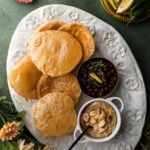
Halwa Puri
Halwa Puri is a comforting, hearty meal that's popular in India and Pakistan for weekend breakfast or during festival season. It's made of puri (or fried bread) and a sweet halwa with a semolina base for a delicious balance of sweet and savory flavors. It's often accompanied by a yellow or black chickpeas curry.
Servings: 7 servings
Calories: 543kcal
Ingredients
Puri
- 1 cup atta (chapati flour)
- 1 tablespoon vegetable oil
- ¼ cup water
- 1 cup neutral oil for frying
Suji ka Halwa
- 1 cup semolina
- ½ cup ghee
- 1 ¼ cup sugar
- 2 tablespoon golden raisins
- 4 cups water hot
- ½ teaspoon ground green cardamom
- pinch saffron (optional)
- finely chopped almonds almond flakes, or unsalted cashews, to garnish
Dry Kala Chana (optional)
- 1 cup black chickpeas dried
- 3 cups water
- 1 teaspoon salt
- 1 tablespoon ghee
- ½ teaspoon cumin seeds
- pinch of asafoetida
- 1 inch knob of ginger grated
- 2 green chilis sliced
- ¼ teaspoon garam masala
- ¼ teaspoon coriander
- ¼ teaspoon ground turmeric
- 1 tablespoon tamarind paste
- cilantro to garnish
Instructions
Puri
- Add the atta into a mixing bowl. Pour in the oil. Then, slowly add the water in while mixing everything together with your fingers until the flour is hydrated and you have a coarse dough.
- Knead the flour together until it forms a rough ball of dough. The dough should be hard when you push a finger into it. Lightly brush some oil on top of the dough and cover it with cling wrap or a kitchen towel. Let it rest for 10 minutes.
- After resting, knead the dough again into a smooth ball. Roll the dough out into a log. Cut the log into 8 equal-sized pieces. Roll each piece into a ball. Work with one dough ball at a time. Roll the dough out using a rolling pin into a circle as large and thin as possible without tearing it.
- In a deep wok or dutch oven for frying, heat neutral oil for deep frying. It'll start to shimmer once it's hot and ready for frying. Carefully transfer the rolled out dough to the oil, slipping it in from the edge of the wok and into the oil. With a slotted spoon, gently hold the dough under the oil until it begins to puff. Fry until golden, about 1 minute total, and flip on the other side.
- Gently push the puri under the oil again for about 10 seconds and then fry until golden brown, about a minute. Transfer the puri to a plate lined with paper towels to drain excess oil. Repeat with the rest of the rolled out puri dough.
Suji ka Halwa
- Heat a nonstick pan on a low to medium flame. Add the semolina into the pan and dry roast it until it starts browning, about 3-4 minutes. It'll turn a few shades darker than the light beige it starts at and emit a nutty aroma.
- Add the ghee into the pan. Let the ghee come to a bubble as you are mixing it into the semolina. Keep stirring the mixture until it's golden brown.
- In the meantime, heat the water in a pot or in the microwave until hot. Add the sugar into the water and stir until fully melted.
- Add the sugar water into the pan with the semolina and ghee mixture. Stir it together and then cover with a lid, as it'll start to sputter. Cook for 5-6 minutes, stirring every minute or two to prevent the halwa from sticking and burning.
- Once the halwa has thickened but still a bit liquidy, add the golden raisins and ground cardamom. Stir in the raisins and cardamom and replace the lid.
- Once the halwa is thick enough that it stops splattering, remove the lid. Continue stirring until the halwa sticks together in a clump and doesn't stick on the sides. Remove from heat. Serve the halwa warm with almond flakes or chopped almonds.
Dry Kala Chana (optional)
- Soak the black chickpeas in 3 cups of water for 4 hours or overnight. Once they have been soaked, drain the chickpeas. Bring water to a boil in a pot and add the chickpeas into the water with salt. Boil the chickpeas until they're soft and can squish between two fingers. Alternatively, add the chickpeas to a pressure cooker with the 2 cups of water and salt for 40 minutes, or until the whistle goes off 3-4 times.
- In a saucepan, melt the ghee. Once melted, add the cumin seeds, asafoetida, grated ginger, and green chilis and allow the spices to bloom in the ghee for 1 minute. Then, add the coriander, turmeric, and tamarind paste into the oil and give everything a good mix.
- Drain the boiled chickpeas, saving ½ a cup of the water the chickpeas boiled in. Add the liquid from boiling the black chickpeas in to the saucepan with the spices.
- Transfer the black chickpeas into the saucepan, stir, and allow the liquid to simmer off. Once it has simmered off, add the garam masala and mix again. The spices will coat the chickpeas in a delicious dry sauce.
- Garnish with chopped cilantro.
Notes
Instead of Dry Kala Chana, you can try the curry version - Kala Chana Masala. Alternatively, yellow chickpeas curry is delicious too - check out this recipe for Chole.
For more in depth information, you can see the individual recipes for Puri and Suji ka Halwa.